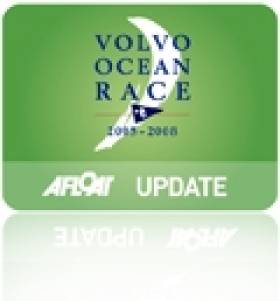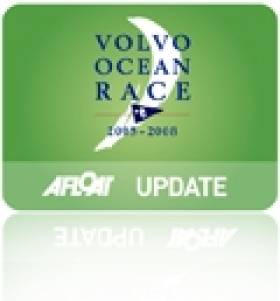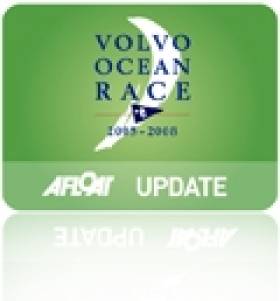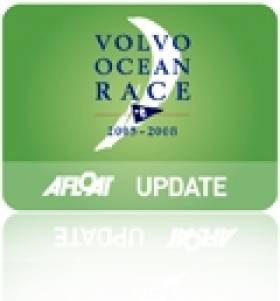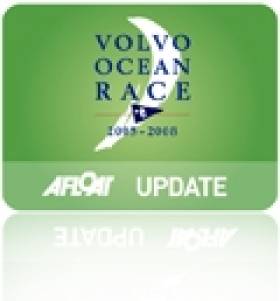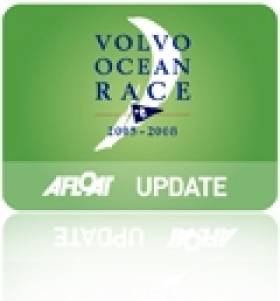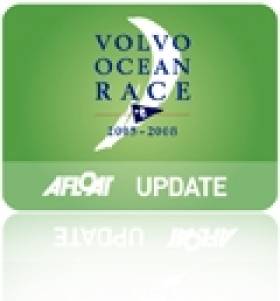Displaying items by tag: Volvo Ocean Race
Team Vestas Abandoned, All Crew Rescued in VOR Drama
#vor – Team Vestas Wind crew were rescued in the small hours of Sunday morning after the Danish team's Volvo Ocean Race boat was grounded on a reef in the Indian Ocean, forcing them to abandon it.
All nine members of the team – inlcuding County Kerry's Brian Carlin – were uninjured in the drama, which unfolded from 1510 UTC on Saturday when their Volvo Ocean 65 hit the reef in Cargados Carajos Shoals, Mauritius.
For several hours, the crew stayed onboard their stricken vessel whose stern was being beaten badly by the waves as it was stuck fast in the reef with the bow facing the ocean.
The rudders were broken in the collision and the stern began taking on water although the stern compartment was locked tight.
Finally, around midnight, the team led by skipper Chris Nicholson (AUS) abandoned the boat and then waded, knee-deep through the sea to a dry spot on the reef from where they could be rescued by a coastguard RIB at daybreak at around 0230 UTC.
They were transported to the tiny islet of Íle du Sud, part of Cargados Carajos Shoals, which is also known as St. Brandon and situated some 430 kilometres to the north-east of Mauritius.
Kept informed
Race organisers and Team Vestas Wind will now attempt to take them from there to the mainland. Race Control in Alicante, Spain kept the Maritime Rescue Co-Operation Centre (MRCC) informed throughout the incident.
Team Vestas Wind's rival race crew, Team Alvimedica (Charlie Enright/USA), diverted to assist in a rescue mission if necessary but were eventually cleared to continue racing north after it was apparent that the Vestas crew were no longer in danger.
Navigator Will Oxley (AUS) sent this report from Team Alvimedica: "All is well on board, though it is fair to say we are all shattered and quite emotional about what happened.
"We are really pleased we were able to be of assistance and that the crew of Team Vestas Wind are all well and we look forward to a beer with them as soon as possible."
The Danish team's concern now will be a salvage mission for their boat but it was not immediately clear how much damage the incident had caused.
Knut Frostad, Volvo Ocean Race CEO, said it was also not yet known why Nicholson's crew had hit the reef, but this would be examined in due course.
"I'm extremely relieved that every one of the nine crew members now are safe and that nobody is injured," he said. "That has always been our first priority since we first learned about the grounding.
'Deeply saddened'
"At the same time, I'm deeply saddened that this happened to Team Vestas Wind and Chris Nicholson and his team. It's devastating for the team, for the race and for everyone involved. I really feel for Chris and the team right now and we will continue to support them all the way going forward."
Team Vestas Wind was the last of the seven crews to announce their participation in the race with just six weeks to go before the event began in Alicante on October 4.
However, Nicholson, who was second on Camper and Puma in the last two editions, assembled an experienced crew backed by talented young sailors from Denmark.
They were fifth when the boat was grounded and were fourth in the opening leg from Spain to Cape Town.
"The safety and wellbeing of the crew has been our only concern during these difficult hours," said Morten Albaek, CEO of Vestas Wind Ocean Racing.
"We are extremely grateful to the team at Volvo Ocean Race and to Alvimedica for their support and outstanding professionalism during the rescue operations. The extent of the damage to the boat will be evaluated and dealt with from here on."
Meanwhile, Leg 1 winners Abu Dhabi Ocean Racing (Ian Walker/GBR) took the second stage lead from Spanish rivals MAPFRE (Iker Martínez/ESP) by 0340 UTC on Sunday with Team Brunel in third. But this was not a day when lead changes seemed important at all.
Volvo Ocean Race On Cyclone Watch As Fleet Heads North On Leg 2
#VOR - The Daily Sail has a comprehensive update on the Volvo Ocean Race fleet as Leg 2 from Cape Town to Abu Dhabi gets underway, with the emphasis over the first few days firmly on getting the furthest east as quickly as possible.
Now five days into a leg that was cut short last time out over piracy concerns, the fleet has more or less converged a few hundred miles due south of Madagascar, with just 9.5 nautical miles separating sixth-place Team Vestas Wind from the current leaders Team Brunel.
And it's an incredibly marginal lead at best, with MAPFRE only half a nautical mile behind in second, and Donfeng Race Ream and Abu Dhabi Ocean Racing close behind.
Even the current last place all-women squad Team SCA are less than 25nm off the front, and have every opportunity to catch up with nearly 4,000nm left to go as the fleet drifts into a tricky area free of wind.
That situation is set to change dramatically in the coming hours as the team's navigators track a tropical cyclone forming south of the Maldives and headed their direction as the week progresses.
With wind speeds of 40 knots forecast, it could give the fleet the chance they need to slingshot north - provided the storm turns the right way.
The Daily Sail has much more on the story HERE.
Slattery & Abu Dhabi Win Volvo Ocean Race Inshore Race off Cape Town
#vor – The Volvo Ocean Race marathon front-runners sure can sprint as well. Ian Walker's offshore leaders – with Ireland's Justin Slattery onboard – proved to the rest of the seven-strong fleet that they are currently masters closer to land too, winning the Cape Town In-Port race on Saturday after yet another thrilling finish.
Abu Dhabi Ocean Racing already lead the hunt for the Volvo trophy after claiming victory in Leg 1 last week and now they are looking to be serious contenders for the in-shore series silverware.
The fleet was split from the start in challenging conditions in Table Bay, under the famous Table Mountain, with winds veering dramatically between 12 and 20 knots and rain clouds threatening throughout.
Ian opted for a port line early in the sprint for the first mark and it paid immediate dividends as they and Team SCA raced clear.
The team from the Emirates have already shown they can make the right decisions under the toughest of pressure.
They edged out Dongfeng Race Team by just 12 minutes in a thrilling Leg 1 climax last week, after 25 days of sailing from Alicante to Cape Town.
After some 20 minutes of racing on Saturday, they already looked like they had the points in the bag, especially after one of the rivals for the in-port series prize, Team Alvimedica, suffered a tear in their jib.
Charlie Enright's team had triumphed in the opening in-port race in Alicante back on October 4 but this victory puts Abu Dhabi now back on top of the points table with three (lowest is best).
The battle for second place soon grabbed the attention of most with Team SCA and Team Brunel in a rare old shootout after the Dutch found a burst of pressure midway round.
Brunel's skipper Bouwe Bekking told a press conference on Friday that the in-port series was not a big priority for him.
Ha! Yeah right. He and his crew were plainly giving it 110 percent as they scrambled with Team SCA for the second rung of the poldium.
But these women are very, very determined and as their skipper Sam Davies explained on Friday, strong winds certainly don't scare them after they did most of their pre-race training in similar conditions in Lanzarote.
A problem with a gennaker failing to unfurl cleanly finally scuppered their efforts to keep Bouwe and co at bay and Brunel made one final effort to catch Abu Dhabi up front.
Once again, Ian was ready for the challenge and by the finish line had a winning margin of a couple of hundred metres from Brunel with the girls in third.
Dongfeng raced home ahead of Team Vestas Wind and Team Alvimedica with MAPFRE, last coming into Cape Town in Leg 1, again bringing up the rear.
The Spanish crew, unlike most of us, will be glad to farewell Table Mountain.
For the Azzam crew, they would be glad to do the rest of their sailing in this sailing-crazy city.
"Cape Town can be like that when the wind comes round Table Mountain. We had really good crew work today, I was out of breath just watching them," said Ian.
"We just tried to do the right thing and our navigator, Simon Fisher, did a good job controlling the race. Two down, plenty more to go."
Check out the scoreboard here.
Brian Carlin Wins Inaugural Reporter's Prize At Cape Town VOR Awards
#VOR - Congratulations to Team Vestas Wind's Brian Carlin, who last night picked up the inaugural Inmarsat Onboard Reporter Award at the Volvo Ocean Race's first awards night in Cape Town.
The experienced Irish sailing photographer and filmmaker – and frequent Afloat contributor – was chosen by the award jury for his "brilliant" storytelling and "unique style" via video, photos and text, according to the official VOR website.
What's more, Carlin was selected above some proven veterans in the field, such as Team Alvimedica's Amory Ross, who reported from the Puma boat in the last Volvo Ocean Race.
The awards night at the V&A Waterfront also saw Chinese entry Dongfeng Race Team pick up the IWC 24-Hour Speed Record Challenge title for the swiftest run of the seven-boat fleet, covering a staggering 541 nautical miles on 3 November.
And with their second-place finish in Leg 1, Dongfeng's performance this far will surely be a delight to the race's title sponsors Volvo.
That's the same Volvo that recently purchased a 45% stake Dongfeng Motor Group and now aims to cultivate a significant audience for the VOR in China, as Bloomberg Businessweek reports.
Irish Sailing Review 2014: A Year Of Hope, Regeneration & Success
#irishsailingreview – 2014 has been the year in which Irish sailing regained its international confidence afloat by re-capturing the Commodore's Cup. Having won it in 2010, the national economic collapse prevented any defence in 2012, but in July 2014 the stain and shame of 2012's non-appearance was emphatically wiped from memory with a convincing team victory led by Anthony O'Leary.
Ashore meanwhile, it had taken longer in some quarters for the economic realities to become fully evident and accepted. But for the Irish Sailing Association, a grassroots revolution within the national authority and sailing in general in 2014 resulted in a root-and-branch analysis of the workings of the Association, which had been heading towards financial disaster through a combination of over-staffing, grandiose schemes of expansion and empire-building, and an emphasis on activities and programmes which were remote from the needs of ordinary sailors throughout Ireland.
It took six months to turn round the course of the Association. But on November 5th 2014 the new ISA President, David Lovegrove, was able to announce a far-reaching re-structuring which is already resulting in a leaner and fitter body, better able to provide a realistic service for clubs and the huge diversity of recreational activity on Ireland's seas and lakes.
While all this high profile activity and action has been taking place at international and national level, those Irish sailors who had managed to keep up their sport through the financial downturn – albeit in often very reduced circumstances – continued to sail their boats with the attitude that, while the economic situation was disastrous, it mustn't be allowed to become serious, and in some ways the best course out of the recession was to sail through it. W M Nixon casts an eye over the year's main activities.
In the Irish sailing year, Christmas Day is New Year's Eve. Next morning, on December 26th – St Stephen's Day or Boxing Day or whatever you're having yourself – the annual 628-mile Sydney-Hobart Race starts. It may be on the other side of the world, and it may still be in the very last days of the old year. But Irish interest at home and in Irish-Australia is always high, and in the sailing community it's seen as the start of the new season.
December 26th 2013 was in line with this, as we'd ex-Pat superstar Gordon Maguire – a previous Hobart race overall winner – very much in contention with Matt Allen's totally new Carkeek 60 Ichi Ban, we also had Sean McCarter of Lough Swilly YC skippering Derry/Londonderry in the warmly-welcomed Clipper Fleet of 70-footers designed by Tony Castro (formerly of Crosshaven) which were taking in the Hobart race as part of their global circumnavigating race, and we'd Barry Hurley and Kenny Rumball on the First 40 Breakthrough knowing that in the 2010 Hobart race, the new design's race debut, First 40s had taken first and second overall.
In a rugged race in which the wind got up to gale force and more towards the end, it was a much-loved hundred footer, Bob Oatley's continually-modified Wild Oats XI, which stole all the headlines with line honours, a course record, and a class win. Irish hopes were best met by Sean McCarter, who logged a very clear win in the Clippers. As for Ichi Ban, while she was third in IRC Div 1 and 8th overall, it wasn't quite a stellar performance, reinforcing the views of those of us who think the boat may be just a little too plump by today's lean and hungry standards. And aboard Breakthrough, they'd 8th in class and 29th overall, a useful performance perhaps, but Barry Hurley will be back on December 26th 2014, boosted by his first in class and second overall in October's Middle Sea Race.
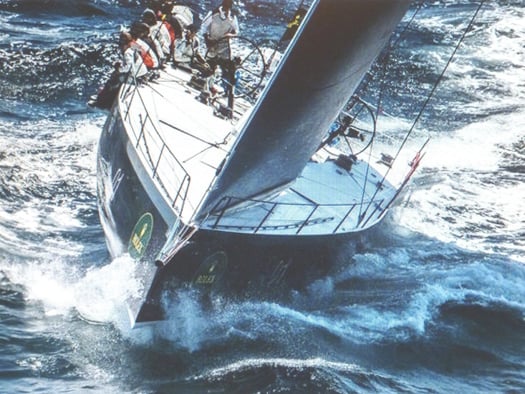
Matt Allen's Ichi Ban in the Rolex Sydney-Hobart Race of 2013, with Gordon Maguire as sailing master. To some observers, the very new Carkeek 60 seemed distinctly plump in her hull form forward compared to her closest competitors
In late January 2014, attention focused on the Quantum Key West Regatta in the Florida Keys, where Irish Olympic sailor Peter O'Leary of Cork was on the strength of New York art dealer Marc Glimcher's completely new and very potent looking Ker 40 Catapult. The boat did the business afloat in Florida, but further business was done ashore, as Anthony O'Leary himself was in Key West to see if he could sign up Catapult to be the secret ingredient in Ireland's Commodore's Cup team, for which at that stage the only certainty was his own older Ker 39 Antix. There seemed to be agreement, but in the volatile world of international trading and snap decisions in which top modern sailing operates, there can be sudden reversals of fortune, and O'Leary later admitted that until Catapult was actually unloaded from a ship in Europe, he hadn't been a hundred per cent certain she'd show.
Key West had further Irish interest in that veteran skipper Piet Vroon's Ker 46 Tonnere de Breskens – a former Round Ireland Race winner – was another star in the show, but much was to happen in Irish sailing before the Round Ireland 2014 got under way in Wicklow on June 28th.
With March slowly showing signs of Spring, university racing came centre stage, and it was University College Dublin which came through on top to qualify as Ireland's representatives in the Student Yachting Worlds in France in October, the team led by Philip Doran.
Another team was emerging as the Irish Cruiser Racing Association (ICRA) announced that our Commodore's Cup squad would be Anthony O'Leary's Ker 39 Antix, Marc Glimcher's Catapult, and the Grand Soleil 43 Quokka chartered by Michael Boyd and Niall Dowling, with Anthony O'Leary as team captain. He in turn would be supported by the shore management team, for a very intense week of racing, of Barry Rose and Fintan Cairns, with Mike Broughton in what would prove to be the particularly onerous task of Team Meteorologist.
As 2014 was exactly midway between two Olympiads, top level international dinghy sailing to Olympic standards might have been expected to be on the back burner. But Ireland's Olympians were very much on track on the international scene, and busy with their own programmes which culminated in the ISAF Worlds in Santander where Olympic places in Rio de Janeiro for 2016 were secured by James Espey in the Laser, Ryan Seaton & Matt McGovern in the 49er, and Annalise Murphy in the Women's Laser Radial. All were of course also seen in other boat types from time to time, with Annalise in particular bringing some glamour to the growing class of foiling Moths in Ireland.
Annalise on the foiling Moth
Other top international women sailors had descended on Ireland in early June with the ISAF Women's Match Race Worlds at Crosshaven. It's very much a specialist sailing interest, but aspiring Irish woman sailors attracted to this discipline found that this successful regatta provided some very useful networking contacts and future crewing possibilities, while the racing itself saw Sweden's Anna Kjellberg of the Royal Gothenburg YC become the new champion after defeating Camilla Ulrikkeholm of Denmark in the final.
In an entirely different area of sailing and life afloat, the traditional boat scene had come early to life with the Baltimore Wooden Boat Festival at the end of May. In the Irish climate after a particularly damp Spring, it reflected great credit on those involved that there was such a good turnout, ranging from the Shannon Gandelows from Limerick recently returned from their historic visit to Venice, through the many restored classic yachts of the region, also including the lovely Shannon cutter Sally O'Keeffe from Kilrush, and going on into the restored traditional mackerel and lobster yawls which make West Cork their home.

Shortly after their historic visit to Venice, the Shannon gandelows built by the Ilen School took part in the Baltimore Wooden Boat Festival at the end of May. The gandelow here, rowed by Liam O'Donghue, Anthony Kenny and Robert Samlle, is headed across Baltimore Harbour towards the gaff ketch Sile a Do.
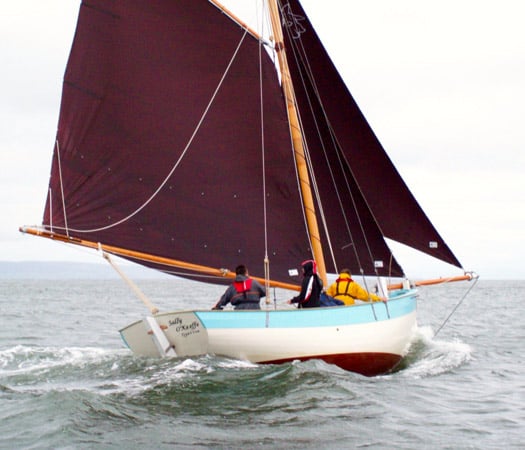
The pride of the Shannon Estuary - Sally O'Keeffe was built in a community effort in Querrin on the Loop Head peninsula.

The traditional lobster boat Saoirse Muireann (left, Cormac Levis) and the mackerel yawl An tiscaire (Uilliam O'Lorcain) are a familiar sight in the waters of West Cork. Photo: Brian Marten
They were to re-appear in even greater numbers at the Ballydehob Gathering of the Boats in early August, a month during which the classic Galway Hookers of the West Coast were at their busiest on their home Atlantic waters, but the East Coast also had its moments with the Riverfest in Dublin's Liffey in early June seeing traditional and classic craft in a lively mix.

Sails in the City – two of the 1898 Howth Seventeens racing in the heart of Dublin in the Liffey Riverfest. Photo: W M Nixon
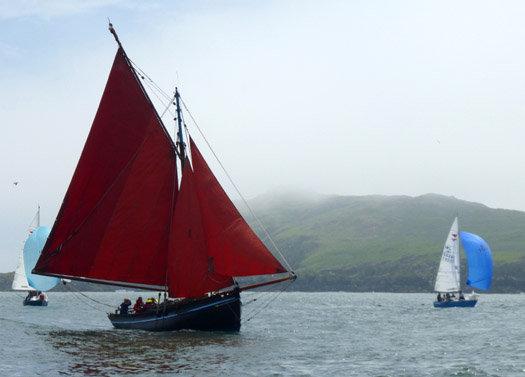
It could almost be Connemara, were it not for the Puppeteer 22s – the Galway Hooker Naomh Cronan in the new Classics & Traditional Division in Howth's annual Lambay Race, which was marking its 110th anniversary in 2014. Photo: W M Nixon
Indeed, so strong is the growing interest in classics and trads on the East Coast that to celebrate the centenary of the Lynch family's Howth 17 Echo (one of the newest of the class, the most senior ones were built in 1898) Howth YC provided a traditional Lambay Race course – simply up around Lambay and back to Howth Harbour – for the Seventeens and a new Classics Division, with the Howth 17s seeing the first two places taken by 1898 boats – Rita (John Curley & Marcus Lynch) and Aura (Ian Malcolm) – while Old Gaffers Association International president Sean Walsh won the classics with his Heard 28 Tir na nOg from the Clondalkin team's Galway Hooker Naomh Cronan. As for the overall prize among the large fleet of more modern boats sailing their more complex course, that was won by Colm Bermingham's Bite the Bullet.
The countdown to the Commodore's Cup had continued with inspirational performances by Anthony O'Leary in the Easter Challenge in the Solent, where he won his class with Antix, and then in June he did the same again with the British IRC Championship. Back home, ICRA held their Nationals with the Royal Irish YC in Dun Laoghaire in mid-June, and out of a fleet of a hundred plus boats it was the vintage Marcus Hutchinson/Rob Humphreys designed Quarter Tonner Quest (Jonathan Skerritt, RIYC) which was best overall scorer, a notably impressive performance also being put in by the Ker 36 Jump Juice (Denise Phelan) from Crosshaven.

The 27-year-old Quarter Tonner Quest (Jonathan Skerritt) was overall winner in the ICRA Nats at the RIYC in Dun Laoghaire. Photo: David O'Brien

Downhill battle at the ICRA Nats with the Mills 36 Raptor (ex-Aztec) in foreground, while beyond is Peter Dunlop of Pwllheli's J/109 Mojito against the XP33 Bon Exemple (Colin Byrne, RIYC). Photo: Davd O'Brien

The Ker 36 Jump Juice (Denise Phelan) dominated Class 0 at the ICRA Nats. Photo: David O'Brien
The end of June, and it was Round Ireland time. Thirty-six boats started from Wicklow, 33 finished in a race which was mostly on the slow side, with mid-size boats having their day. The winner was Richard Harris's Sydney 36 Tanit from Scotland by just six minutes from the home favourite, Liam Shanahan's J/109 Ruth from the NYC in Dun Laoghaire. The French defending champion, Laurent Gouy's Ker 39 Inis Mor which sails in Ireland under the burgee of Clifden Boat Club, placed third while Frank Doyle of Cork, second generation round Ireland aristocracy as son of Denis of Moonduster fame, was fourth with his A35 Endgame.
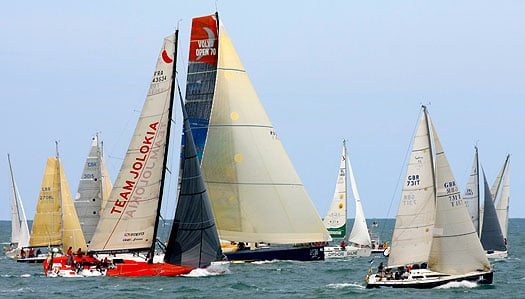
The start of the Round Ireland Race 2014 well illustrates the eclectic nature of the fleet. In right foreground is Richard Harris's Sydney 36 Tanit which was overall winner by just six minutes from the J/109 Ruth (Liam Shanahan), just beyond with the black jib, while the Volvo 70 Monster Project (David Ryan) comes thundering through the fleet at the beginning of a performance whch would see her take line honours win and thd class win in the CK Div.. Photo: Kevin Tracey
The same weekend as the Round Ireland race started, Lough Foyle sent the Clipper Fleet on their way after a week's festivities in Derry/Londonderry, made even more festive by the fact that Sean McCarter and his crew with the home town's boat had crowned their win in the Sydney-Hobart race with victory in the Transatlantic leg to Derry.
Clipper fleet in Derry
Crosshaven fairly leaped to life with Cork Week in July, and after several hitches in various boat-shipping plans, it was notable as the first time the Irish Commodore's Cup Team 2014 were seen together, and mighty impressive they looked too, with Quokka proving best on the Cork Week leaderboard.
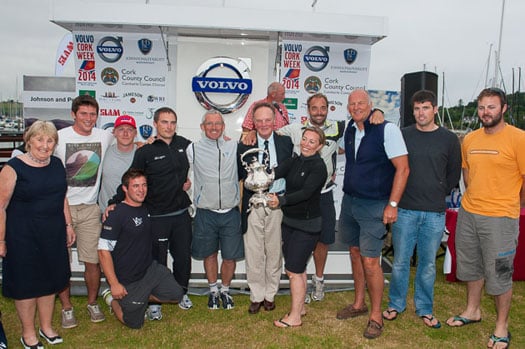
Michael Boyd (centre behind cup) and his Quokka crew, a member of Ireland's Commodore's Cup team, were overall winners of Cork week 2014. Photo: Bob Bateman
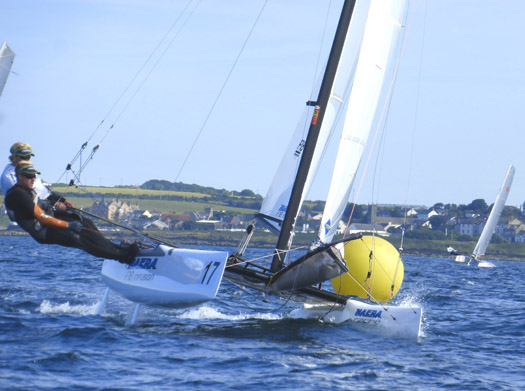
In the F18 Worlds at Ballyholme, Dutch skipper Gunnar Larssen (crewed by Ferdinand van West) is seen here putting in the smooth performance which saw him winning the worlds at his thirteenth attempt. Photo: W M Nixon
While all this excitement in racing boats with lids was building on the south coast in July, up north on Belfast Lough at Ballyholme the F18 Worlds were held for one of global sailing's most popular catamaran classes. Though the entry of 56 boats didn't match the 150-plus entries they get when the class has its worlds in its Mediterranean heartlands, the sailing was good and a popular winner emerged in longtime F18 sailor Gunnar Larsen, who is Dutch despite his Scandinavian name.
Dinghy attention was also very closely focused on Dublin Bay, with an enormous fleet of Optimists at the Europeans hosted by Royal St George YC from 12th to 20th July, and Dun Laoghaire really showing what it can do in being a major international regatta centre. France's Enzo Balanger was tops from Sweden's Kasper Nordenram, while best of the Irish in the Gold Division was Royal Cork's James McCann in tenth – not surprisingly, he was to go on to win the Nationals at his home club in August.

Nations from across Europe and beyond were at the Optimist Euros at Dun Laoghaire

Finn Lynch racing at Douarnenez in France where be became the new U19 Laser Standard world championPhoto: Trevor Millar/Sail Coach
On the broader international scene, former Opty stars Finn Lynch (National YC) and Seafra Guifoyle (Royal Cork) were to turn in outstanding results during 2014, with Guilfoyle firmly in the frame through the ISAF Youth Worlds in the Laser, eventually coming home from Tavira in Portugal with the Silver, while Finn Lynch was on top form to clinch the Gold in the Under 19 Laser Standard Worlds at Douarnenez in Brittany.
Back aboard the boats with lids, late July had brought the Commodore's Cup in the Solent, and if anyone out there doesn't know who won, we'd like to hear from them, as the state of total seclusion which this implies is surely something which could be packaged and marketed to our hyper-informed and over-crowded world. The comprehensive Irish victory just seems better and better with the passage of time, and for Anthony O'Leary it was the highlight of a fantastic season which in September was to see him win the Helmsman's Championship of Ireland (admittedly by just a whisker) in J/80s in Howth to set up a national double for Royal Cork, as young Harry Durcan of Crosshaven was winner of the Junior Helmsmans. O'Leary meanwhile went on to win the 1720 Nationals in Baltimore later that month, and then in November his beloved Antix was named RORC Yacht of the Year.

Antix in the Commodore's Cup, hanging in well coming to the weather mark to stay ahead of the newer Ker 40 Cutting Edge. Photo: Rick Tomlinson)
Even as Antix and her team mates were racing on towards glory in the Solent, in Clew Bay the West of Ireland Offshore Racing Association (WIORA) were staging their annual championship at hospitable Mayo SC, and it saw a good spread of results, with the overall winner being Galway's Liam Burke with his Corby 25 Tribal, while the runner-up was the McGibneys' Dehler Optimum 101 Dis-a-Ray, which sails under the Foynes YC burgee, but her home port is Tarbert further west along the Shannon Estuary.
August was busy with events for enjoyment. Eighty boats raced in Calves Week in West Cork, which has now been compressed to a four day regatta which means, as one sage family man observed, that you can take a house in Schull for a week's holiday, and then just as the wife and kids are getting fed up with having the ould fella always about the place, doesn't he absolutely have to go off and spend the last four days of the holiday sailing with his mates? That one of the top boats was Colman Garvey's True Penance maybe says it all.

Calves Week 2014 entries were up 25% in 2014. Photo: Bob Bateman

The GP14 Worlds at East Down YC in Strangford Lough launched a hundred boats every day in smooth style. Photo: W M Nixon
The biggest dinghy event of all (other than the Laser Nationals, which as ever are in a league of their own) was the GP 14 Worlds in mid-August at East Down YC in Strangford Lough, which had its excitement in a sudden storm on the Monday, but it all turned out okay. Boats involved were just over the hundred mark, the best boats were built in Northern Ireland by Alistair Duffin, and winners were English crew of Ian Dobson and Andy Tunnicliffe from Burwain, while top Irish were John and Donal McGuinness of Moville in Donegal, they were sixth.
At the other end of the intensity scale, down in Howth they had their first cruiser-racer two-hander for the Aqua Restaurant Challenge. Despite very restrained pre-publicity, it attracted 34 boats for a race round Lambay and the Kish. Stephen O'Flaherty's elegant Spirit 54 Soufriere, fresh from a win in the Panerai Classics in Cowes and co-sailed by David Cagney, took line honours and almost won, but the vintage Humphreys Half Tonner Harmony (Peter Freyne and Jonny Swann) just pipped them at the end.
Sailed in summery weather, the new Howth two-handed was about as different as possible from another two-handed experience in August, that of Liam Coyne (NYC) and Brin Flahive (Wicklow) in the 1800 mile RORC Seven Star Round Britain and Ireland. They didn't have to be two-handed, there were fully crew boats involved including the 70ft–trimaran Musandam in which Ireland's Damian Foxall played a leading role in taking line honours in record time, but aboard the First 36.7 Lula Belle the Irish duo just toughed it out despite sailing the last 500 miles with virtually nothing functional, they simply decided to see it through, and to their amazement found they'd won Classes V & VI.
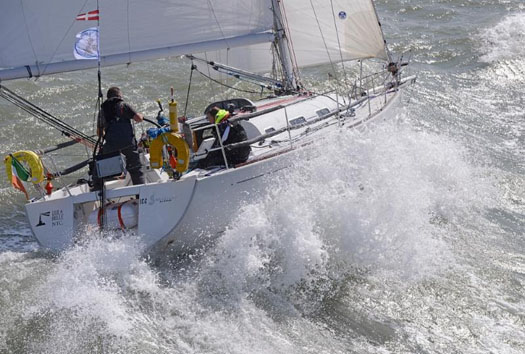
Lula Belle on her way out of the Solent with 1800 miles to race. Photo: Rick Tomlinson
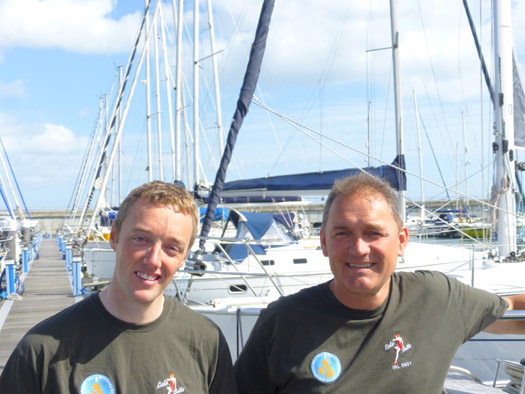
Brian Flahive & Liam Coyne back in Dun Laoghaire on the morning of their return from the finish of the Round Britain & Ireland Race. Photo: W M Nixon
As for the Laser Nats, they were at the end of August and another Ballyholme event, with Johnny Durcan of Royal Cork winning from Rory Fekkes of the home club, while the radials saw Annalise Murphy keep her hand in with a win from Cork's Cian Byrne.
After some rugged August weather, particularly on Ireland's East Coast, September was utterly blissful and it sweetly rounded out Dublin Bay Sailing Club's 130th season, the birthday being marked by a fairly epic dinner in the National YC. September also saw the conclusion of the slowly but steadily reviving Irish Sea Offshore Racing programme, with the end-of-season race from Pwllheli to Dun Laoghaire seeing Liam Shanahan's J/109 Ruth confirmed as the overall winner of the series. Among locally campaigned dinghies, meanwhile, Dun Laoghaire's keen Fireball Class kept its annual programme in lively shape, and the season drew a close with Barry McCartin and Conor Kinsella winning overall from Noel Butler and Stephen Oram.

ISORA Champion Ruth skippered by Liam Shanahan jnr from the National Yacht Club
Across country in Limerick, the CityOne dinghies and the traditional Shannon gandelows created in projects of the Ilen Boatbuilding School made their debut in the city centre on one of the last days of the Indian summer, and then they were put on display in a Naumachia in St Mary's Cathedral which was officially opened by Michael Noonan TD, and later formally visited by President Higgins.
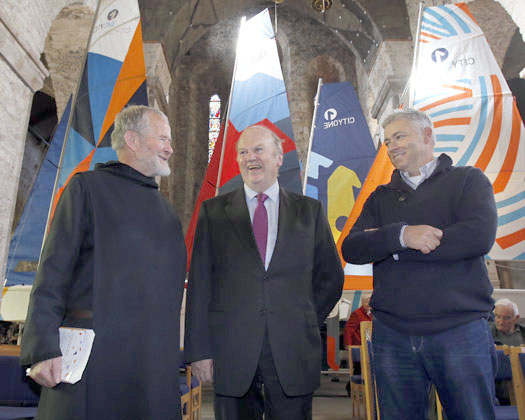
The hopeful new spirit of Irish sailing in 2014 was evident in St Mary's Cathedral in Limerick, when the CityOne dinghies built by volunteers in an inner city revitalisation project went on display in a Naumachia in the Cathedral on September 26th, after their first regatta on the Shannon in the heart of Ireland's City of Culture 2014. With the boats in the cathedral were (left) Brother Anthony Keane of Glenstal Abbey (Director, the Ilen School), Limerick's senior TD and Ireland's Minister for Finance Michael Noonan, and Gary MacMahon (right) Director of the Ilen School & Network for Wooden Boatbuilding. Photo: Press22
And then more vigorous winds returned in October, with the Freshwater Keelboat event on Lough Derg – originally just an exclusive Dragon thing – finding itself swamped with sixty and more boats from five classes and increasingly rugged conditions, such that only the Dragons and Squibs managed to get in any meaningful racing, with Neil Hegarty (RStGYC) winning the Dragons while James Matthews and Rob Jacob of Kinsale topped the Squibs.

Dragons in Autumn action on Lough Derg – Neil Hegarty (right) was overall winner from runner-up Richard Goodbody (left) Photo: Gareth Craig
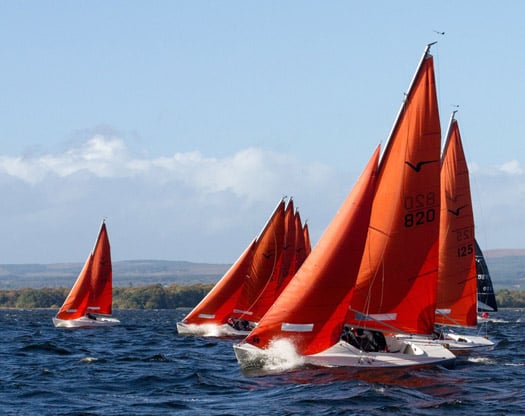
Squibs on Lough Derg – it may look like perfect sailing, but the top came off the weather very soon afterwads. Photo: Gareth Craig
The Student Yachting Worlds in La Rochelle in October had some hiccups in UCD's campaign for Ireland, but while they very narrowly missed the podium in a truly international event, they stayed put at fourth overall. And round in the Mediterranean, a record fleet for the Rolex Middle Sea Race from Malta saw entries soar through the 120 mark for the first time, and the 606 mile race had its first half in light breezes, but the second half was in pure Mistral, with people talking of "winds easing to 44 knots....." A Maltese-owned J/122 won, but second overall and first in her class was the Xp44 XpAct (Josef Schultheis) with a strong Irish emphasis in her crew including Barry Hurley, Andy Boyle, Kenny Rumball and Phillip Connor.
Soon afterwards, the Volvo World Race got under way with first stage from the Med to Cape Town, and Ireland's Justin Slattery on the winning boat on Leg 1. Back home, Autumn leagues had seen renewed enthusiasm as though people had suddenly re-discovered their sport, and the great sailing year of 2014 drew towards its close with the Lasers in Howth starting their 40th winter of annual frostbite racing. This means that HYC have now had a continuous sailing programme since April 1974, while across in Dun Laoghaire the DMYC Frostbite Series must be the most senior of all winter events. Winter Leagues attract more aficionados, with the popularity of the Dublin Bay Turkey Shoot in particular providing a forceful reminder that Dun Laoghaire is the principal sea access for a notably affluent and very large population in South Dublin. With the Turkey on its way, soon it's Christmas. And then the new Irish sailing season will begin on the blue waters of Sydney Harbour.
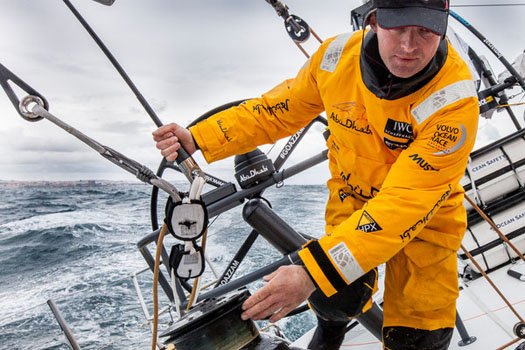
Justin Slattery on Volvo World Race 2014. Photo: Volvo Ocean Race
Change Afoot In Spanish VOR Team After Poor Leg 1 Result
#VOR - Change is afoot within the MAPFRE camp at the Spanish entry in the latest Volvo Ocean Race takes stock after their last-place finish in the first leg from Alicante to Cape Town.
As the official VOR website reports, the Spanish yacht ran into a virtually windless patch of sea in the shadow of Table Mountain, allowing the women of Team SCA to nab sixth place last Friday (7 November) two days after Abu Dhabi won Leg 1 by a matter of minutes over Team Brunel.
The first casualty of the poor result is Michel Desjoyeaux, who steps down as watch captain on board but will remain with the team's onshore crew.
The two-time winner of the Vendée Globe said the decision "is a shared one", going on to cite "strong personalities" as "one of the parameters to manage in the Volvo Ocean Race. You've got to orchestrate everything."
Navigator Nico Lunven will also make way for Jean-Luc Nélias, who plotted Groupama's course to VOR victory in 2012.
The VOR website has more on the story HERE.
Abu Dhabi Ocean Racing Wins First Leg of 2014-15 Volvo Ocean Race
#VOR - Abu Dhabi Ocean Racing's VOR 65 Azzam was the first yacht across the finish line in Cape Town this afternoon (Wednesday 5 November), taking Leg 1 of the 12th edition of the Volvo Ocean Race.
The win marks an Irish triumph, too, with VOR veteran Justin Slattery serving as bowman, trimmer and helmsman among a crew that has faced a tough battle for first place since leaving Alicante more than three weeks ago.
Indeed, for the past week Abu Dhabi have been almost neck and neck with Dutch entrants Team Brunel and Chinese debutantes Dongfeng Race Team – the latter coming within one nautical mile of the leaders as Table Mountain came into view, as the VOR website reports.
But the wind shadow caused by that landmark slowed both boats down – and more importantly, provided the opportunity Ian Walker and his crew needed for the final push ahead to victory at 15:10 UTC.
Neck & Neck to Cape Town in Volvo Ocean Race Leg One Finish
#vor – After 19 days & 3,000 miles sailed in the first leg of the Volvo Ocean Race, the top three teams can still see each other as they approach Cape Town, south Africa and the end of leg one. Irish sailors on two leading teams are blogging about their latest experiences including some good insights from Abu Dhabi Team Director Jamie Boag from Belfast, here.
Also giving a picture of life on board Team Vestas is Brian Carlin, the onboard reporter from County Kerry. His latest onboard account is here.
Abu Dhabi, Team Brunel and Team Vestas Wind are locked against each other with Dongfeng Race Team just 17NM further adrift.
It is unlikely that any boat will gybe away from their starboard course, as this will take them into less wind and point back at North Africa.
Matt Knighton, the OBR onboard Abu Dhabi Ocean Racing, commented: "One might think that after 19 days of racing and being thousands of miles from land we're surprised to see another boat so close. To be honest, we're not.
"The shock of how close this one-design racing is has worn off. After the earlier battle down the African coast, it's not surprising to see one or even two sails keeping pace with you for a very, very long time."
Dongfeng is the most inside boat but, as we have been saying for some days, those closest to the high would trade wind speed for shift.
Right now the trade is not looking like a good one as the lifted inside shift is not paying them with enough wind speed to make the deal work.
Team Alvimedica is on the opposite side of the coin: more wind less shift. Lets see who is right.
Team Vestas Wind is the stalking horse here. So far from passing Fernando, navigator Wouter Verbraak has looked at times like he has lost the plot and others like a tactical genius. Right now, Wouter is looking more right then wrong.
Meantime, at the back of the fleet, it's been tough work.
Team SCA has dropped off the pack in a lot less wind while MAPRFE has been struggling too after suffering water ingress and some electrical issues.
Volvo Ocean Race Fleet Put Equator Behind Them
#VOR - All seven teams in the Volvo Ocean Race have crossed the Doldrums into the Southern Hemisphere as they make tracks towards Cape Town on the first leg of the 12 edition.
And for Abu Dhabi Ocean Racing's onboard reporter Matt Knighton - the only one of the fleet never to have crossed the Equator before - there was time for a fishy initiation as per Royal Naval tradition, welcomed by 'King Neptune' as a true 'Shellback'.
Abdu Dhabi can afford a little time out for fun, as they emerged from the Doldrums at the front of the fleet, sailing south towards Fernando de Noronha off the coast of Brazil with a six-nautical-mile lead on nearest rivals Team Brunel.
Team Vestas Wind aren't far behind, either, just 34 miles distant, while the rest are beating across the South Atlantic at an average of 16 knots, some change from the calms of the Doldrums.
But as the pace picks up, so do the conditions at sea. As the Volvo Ocean Race website reports, it's now time for "full foul weather gear, helmets and goggles" to protect from the impact of bigger waves.
The full fleet of seven are expected to have passed their Brazilian waypoint by tomorrow morning, with the next stop being South Africa some 3,300 miles and 12 days away.
Abu Dhabi's Justin Slattery – Ireland's Volvo Ocean Racer
#justinslattery – Born in Cork, grew up in Ireland, Justin Slattery learnt to sail in Cork Harbour with Eddie English writes Marcus Hutchinson. By signing up to sail on board Abu Dhabi in this year's Volvo Ocean Race and sail his fifth Volvo Ocean Race Slattery has passed both of Ireland's other round the world veterans Gordon Maguire (with four races) and Damian Foxall (with three Volvos, a Jules Verne and a Barcelona World Race).
My First Race
I joined the 60-footer Newscorp in the 2001 Whitbread race. I had already been sailing Maxis on the professional circuit for over five years by then, racing either with or against most of the crews that would have been involved in the round the world scene at the time. In some ways it was almost a natural progression for me to get involved with the round the world race. It was something that I had been looking forward to getting into from the first day I heard about it.
The Moment
The moment when it clicked that this was something I wanted to do a lot of came I think when we set off from Southampton heading for Cape Town in 2001 and I thought, wow, I'm finally here racing with all these guys I've been reading about for years, my dream has finally come true, an amazing feeling. In some ways I'd made it to the start but I had yet to prove that I could actually do it.
The Southern Ocean
Leg 2 heading down into the Southern Ocean from South Africa. You've read about it, you've heard the stories, now you've got to get through it. I can tell you it lived up to everything it was supposed to be. One of the most frightening places in the world to be but also some of the most fun and exhilarating sailing you could ever do.
Race-end euphoria
There is always a massive anticlimax at the end of the race. The first time I finished it I realised I'd completed the race that I'd been thinking about for years and years. I asked myself, "what's next?" Finishing it was one thing but it was became an obvious decision to go back out there again and try and win it next time. Following finishing my first race I spent a year racing everything from TPs to Maxis, anything that was relevant. And then I got the call to go and sail on ABN Amro. I got the call. I didn't make the call. For the previous race I had kicked just about every door down in an attempt to get a spot on board, but this time the offers came to me. This was great and I felt privileged.
Why did they call me?
In my opinion people called me because they know me for having done so much for my experience. I'd worked all my life towards this. I had made the investment in time and energy but it is still a huge privilege to get that call. All the names on board ABN Amro were A-listers of the offshore world and now I was there too. To win the race was also a lifetime ambition achieved.
Never again
I probably said never again at the end of that amazing race on ABN Amro but it doesn't take long before you realise that you just can't touch that kind of fully crewed sailing in any other place and I'm back now for edition five. It is still untouchable. It is the highest level of offshore racing you can do in the world, bar none. In 2008 I was called to join the Irish Green Dragon team and the skipper of that boat, Ian Walker, was my skipper again for Abu Dhabi last time in 2011 and again this time.
Why I went back to Abu Dhabi
It was natural for me to go with Abu Dhabi again this time. I raced with them three years ago in the previous race and we didn't have a great race last time, the boat was really slow. The opportunity came again and this time I knew it was going to be very different with the one design boats. I knew we weren't going to have a boat speed deficit like last time. I know it would be only up to us. It is still going to be a really tough time though.
10 years from now
I have absolutely no idea what I'll be doing in 10 years time. I'll probably be racing somewhere or other but probably not doing the Volvo Ocean Race. The more I've been involved in this scene the more I realise there are other opportunities out there too, especially in the commercial side attached to it. I do a lot of rigging for new projects and builds. I do a lot of consultancy on racing projects. There is a lot of work out there aside from the racing itself.
Advice for young people
Do as many offshore races as you possibly can. There are some great offshore races around the place, and around Ireland there are plenty. People are always looking for crew and you need to just put the miles in. Not everyone on board can be an expert or a professional but if you are keen and show the right attitude you'll get on board and then its up to you how you go from there. Keep trying to be the best at what you do. Never give up!
Skills
You need a secondary skill in life no matter how good you are. You can race non-stop but it is really useful to have a secondary skill-set, especially in the world we live in. When we leave the dock we have just the skills that are in our heads and its amazing what you can fix at anytime in any part of the world with the group of people that are the crew of a Volvo boat and without outside assistance. On our boat we have a sailmaker, an engineer, a rigger and a boatbuilder, and a guy who can fix any electronic system. Anyone who wants to get deeper into offshore racing needs to have at least one other serious skill.
One Design
The boats are really close. Volvo have done an incredible job to get seven boats built to such exacting standards. I was more than pleasantly surprised by how good a job had been done. Except for their colours schemes the boats could not be more One Design. You'll see the fleet swarming together all the time. All boats in the fleet will have a piece of the podium at some stage. To win this race you will have to be consistently there and maybe get a fist full of bullets too. A big challenge!






























